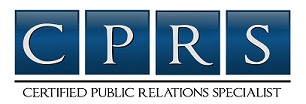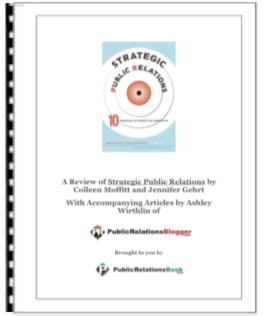________________________________________________________________________

Like most materials used in the public relations world, brochures are used to inform, engage, and call people to action. A brochure is a piece of paper (or digital copy) that is usually folded into three sections with information inside and out about an event, company, brand, etc., that the company wants to share with the public and buyers. The PR brochure can be a regular company brochure, but they can be more successfully targeted. More effort should be put into those that are being used for a specific goal and purpose as a part of your PR campaign.
The PR brochure is different than a sales brochure. While most of PR aims at getting support, donations, buyers, etc., the PR brochure can be seen as more of an informational piece of marketing/public relations materials. Like the press kit, you can still instill trust, persuade people to support, or share accomplishments. The difference here is that PR tactics are usually less in-your-face and less sales oriented.
A PR brochure is an effective way to share a lot of information in a quick and easily digested form. Companies can also make these brochures registration/donation/opt-in forms that readers can send in. Brochures can be used year-round, but as mentioned above, create specific and targeted brochures for your fundraising (or other special) events.
To create an successful brochure, you must include the right information that will get people interested and acting. Just like website copy, a press release, or media pitch, a brochure needs to be newsworthy. (For tips on being newsworthy, check out: PR Writing | 5 Tips to Making Your News Newsworthy.) Just like a blog post, media pitch, or press release, yours won't be read if it's not interesting or newsworthy.
Brochures can be used offline and online, so be sure to optimize them for keyword searches if you plan to publish them to your website as well. Google indexes PDFs as well as webpages, so use links, keywords, and other calls to action there to get the most out of your brochures.
To get you started, here are a few tips for creating a PR brochure:
Lastly, be sure to include the following components:
Public Relations Materials | 3 Tips for Creating a PR Brochure
________________________________________

Like most materials used in the public relations world, brochures are used to inform, engage, and call people to action. A brochure is a piece of paper (or digital copy) that is usually folded into three sections with information inside and out about an event, company, brand, etc., that the company wants to share with the public and buyers. The PR brochure can be a regular company brochure, but they can be more successfully targeted. More effort should be put into those that are being used for a specific goal and purpose as a part of your PR campaign.
The PR brochure is different than a sales brochure. While most of PR aims at getting support, donations, buyers, etc., the PR brochure can be seen as more of an informational piece of marketing/public relations materials. Like the press kit, you can still instill trust, persuade people to support, or share accomplishments. The difference here is that PR tactics are usually less in-your-face and less sales oriented.
A PR brochure is an effective way to share a lot of information in a quick and easily digested form. Companies can also make these brochures registration/donation/opt-in forms that readers can send in. Brochures can be used year-round, but as mentioned above, create specific and targeted brochures for your fundraising (or other special) events.
To create an successful brochure, you must include the right information that will get people interested and acting. Just like website copy, a press release, or media pitch, a brochure needs to be newsworthy. (For tips on being newsworthy, check out: PR Writing | 5 Tips to Making Your News Newsworthy.) Just like a blog post, media pitch, or press release, yours won't be read if it's not interesting or newsworthy.
Brochures can be used offline and online, so be sure to optimize them for keyword searches if you plan to publish them to your website as well. Google indexes PDFs as well as webpages, so use links, keywords, and other calls to action there to get the most out of your brochures.
To get you started, here are a few tips for creating a PR brochure:
- Create a brochure that fits your company identity. This means that your brochure needs to not only reiterate your identity, but also be in line with your representation elsewhere. If your company has chosen an identity of being young, fun, and spontaneous, make sure your brochure shares that same feel. Utilize the motto and mission statement your marketing team has already created, and be sure to include the company's philosophy. If the company's aim is to make the world a better place, tie that into your event. So long as it helps to emphasize the company's mission (instead of opposing it) share that with your audience.
- Create a newsworthy brochure. As mentioned above, newsworthy makes or breaks the success of your brochure. The main components that make up a newsworthy brochure are: relevant, timely, and significant. The brochure will generate no interest if your targeted audience does not find the information contained therein to be of importance to them. Why does the information in your brochure matter? Are you helping the community, changing things? Then say so! Customers/buyers/readers care about things that are important to them and affect their lives in some manner (hopefully positively).
- Create a brochure that stands out from the rest. The standard (and boring) brochures we see in community place, like the grocery store, are just that: standard (and boring). Create a brochure that is not only newsworthy but also aesthetically pleasing and eye-catching. Look into colors that makes sense to use; utilize your logo/brand; make the brochure "pop". If you need help in this area, get it! That's what the experts are for.
Lastly, be sure to include the following components:
- You logo and company name.
- Your company info; your mission; your goal.
- The reason for the brochure.
- Why that reason is important to the reader.
- Next steps (calls to action).
- Contact information.
________________________________________________________________________
 Long answer short, no. There are many reasons for the answer to the question posed in the title to be no, but the main reason: not all firms/companies/brands are the same. Additionally, the formula would need to change on an almost daily basis to accommodate the changing industry and PR world.
Long answer short, no. There are many reasons for the answer to the question posed in the title to be no, but the main reason: not all firms/companies/brands are the same. Additionally, the formula would need to change on an almost daily basis to accommodate the changing industry and PR world.
There are firms that recognize this need to do away with the cookie-cutter form public relations can take, but then there are also firms stuck in the past conducting PR activities as if nothing had changed. How can that be successful? (Hint: it can't be.)
In order to create the most successful public relations campaign/plan, you must tailor it to the firm, the firm's target market, and the firm's buyers. That's not to say, however, that you can simply change the name of the firm, their target market, and their buyers in a preset plan. No, more things have to change in order to be tailor made.
How does one do that? Well, you can:
The important thing to remember is that there is no magic in PR. There may be some optical illusions or smoke and mirrors, but PR should be more about being transparent and providing a relationship with the public, as that's what public relations is all about. That "public" can change depending on who you're targeting, though; for example, if your target market is businesses, your B2B model will affect the way your PR is done, so be sure to take that into account.
If you feel you need assistance creating your own PR plan, or do not want to use the services of a public relations firm/boutique, be sure to ask for help. Internally or externally, you will need the help of someone to give you the best picture of who your target market is, and how you should reach them. This crucial component and piece of information, knowing how to reach your target market, is the reason there is no magic formula to PR.
The Public Relations Formula | Is There Such a Thing?
________________________________________
 Long answer short, no. There are many reasons for the answer to the question posed in the title to be no, but the main reason: not all firms/companies/brands are the same. Additionally, the formula would need to change on an almost daily basis to accommodate the changing industry and PR world.
Long answer short, no. There are many reasons for the answer to the question posed in the title to be no, but the main reason: not all firms/companies/brands are the same. Additionally, the formula would need to change on an almost daily basis to accommodate the changing industry and PR world.There are firms that recognize this need to do away with the cookie-cutter form public relations can take, but then there are also firms stuck in the past conducting PR activities as if nothing had changed. How can that be successful? (Hint: it can't be.)
In order to create the most successful public relations campaign/plan, you must tailor it to the firm, the firm's target market, and the firm's buyers. That's not to say, however, that you can simply change the name of the firm, their target market, and their buyers in a preset plan. No, more things have to change in order to be tailor made.
How does one do that? Well, you can:
- Do your homework. This is a phrase I use a lot. It's still as important today as it was the first day I mentioned this vital step in PR planning because it plays a role in the planning process that affects the rest of the plan's success. Conduct research in order to create a plan that will work for your client and their target market/audience. Learn who both parties are so that you can not only tailor their plan, but also tailor the tactics they use to reach their audience.
- Define strategies from the company's goals. Whether in-house or PR firm, the PR team's responsibilities include creating plan goals. These should be based on the company's overall goals and objectives, otherwise you will have little strategy, and the tactics you create from these goals will not produce the results you were hoping for.
- Avoid using the plan they/you used last time. Just like you wouldn't use the same plan from company to company/client to client, you should not use the same tactics/plans for a company, even if the situation, goal, and objectives are the same. The industry, the target market, the economy, can all change, making your plan destined to fail this time around. Just because it was successful in the past does not guarantee its success this time. Be sure to create something tailored not just for the company but also for the changes seen outside the company.
The important thing to remember is that there is no magic in PR. There may be some optical illusions or smoke and mirrors, but PR should be more about being transparent and providing a relationship with the public, as that's what public relations is all about. That "public" can change depending on who you're targeting, though; for example, if your target market is businesses, your B2B model will affect the way your PR is done, so be sure to take that into account.
If you feel you need assistance creating your own PR plan, or do not want to use the services of a public relations firm/boutique, be sure to ask for help. Internally or externally, you will need the help of someone to give you the best picture of who your target market is, and how you should reach them. This crucial component and piece of information, knowing how to reach your target market, is the reason there is no magic formula to PR.
________________________________________________________________________
 Crisis management is a vital component of (and perhaps the second half to positive) public relations. As with all aspects of PR, marketing, and advertising, the internet is changing things up, making them easier and more difficult at the same time. Professionals and companies in all industries are now able to conduct their own PR through the new vehicles provided by the internet, like social networking groups, blogs, websites, and press release distribution. In the same sense, consumers/buyers are also able to contribute to the PR surrounding a company through WOM (word of mouth), reviews, etc., making crisis PR more difficult for companies.
Crisis management is a vital component of (and perhaps the second half to positive) public relations. As with all aspects of PR, marketing, and advertising, the internet is changing things up, making them easier and more difficult at the same time. Professionals and companies in all industries are now able to conduct their own PR through the new vehicles provided by the internet, like social networking groups, blogs, websites, and press release distribution. In the same sense, consumers/buyers are also able to contribute to the PR surrounding a company through WOM (word of mouth), reviews, etc., making crisis PR more difficult for companies.
This latter characteristic of PR today means one important thing for companies: a crisis can grow, and fast. There are things that a company can do to help prevent a crisis from growing too out of hand in the first place, though. One example could be creating and maintaining relationships with consumers, so that when a crisis does arise, buyers know and are perhaps advocates for a company. Companies can also try to diffuse the damage of a crisis as it is taking place. With correspondence, action, and taking responsibility, a company can help to halt the spread of negative WOM a crisis can generate.
Though these things may help to prevent a crisis going too far, there are others who say that a crisis is uncontainable online, and will only spread like a wildfire through cyberspace, destroying any good branding in its path. A crisis today means you're done for; people knowing of the crisis means it's already too late to do anything about it. Examples, of course, are BP, Tiger, and Toyota. But those that have come out alive (barely, perhaps), like Toyota and Woods, took action and responsibility for their actions.
BP never fully accepted responsibility; they spread the blame and opted to do nothing for some time. Now, their solutions are simply causing more negative WOM (because of the side-affects of their actions) and are further feeding the flame. More important, though, is the actual damage they've done to others and the environment, not just their own brand or company. This physical damage reflects where their brand is going.
With examples like these that we've seen in the past few years, it's hard to imagine that any company can come out of a crisis, but it really comes down to how they respond. A crisis can most definitely get out of control if the company let's it. Poor response PR makes for a great breeding ground for negative WOM. This can take place on Twitter, Facebook, even things like foursquare, where consumers can share their frustration, distaste, hatred, etc., for a company, and if enough people agree, the idea can spread far and wide. Take for example BP's alter-ego Twitter account; though hilarious and often spot on, it did nothing beneficial for BP's brand or image, and only helped to reiterate the places where they fell short.
It's easy to agree that a crisis today can mean the end of a company. People are so willing to share their bad experiences. Moreover, for a company that continues to carry on with the same actions, crisis PR is pretty futile. In order to be successful with Crisis PR, a company has to see what caused it (monitoring their actions), what's being said about it (monitoring their brand and WOM), what can be done about it (actions to remedy the situation), and finally has to respond, and quickly.
What do you think? Is it too late for a company to recover if the crisis is already known around the internet?
Public Relations Crisis Management | It's All in The Response
________________________________________
 Crisis management is a vital component of (and perhaps the second half to positive) public relations. As with all aspects of PR, marketing, and advertising, the internet is changing things up, making them easier and more difficult at the same time. Professionals and companies in all industries are now able to conduct their own PR through the new vehicles provided by the internet, like social networking groups, blogs, websites, and press release distribution. In the same sense, consumers/buyers are also able to contribute to the PR surrounding a company through WOM (word of mouth), reviews, etc., making crisis PR more difficult for companies.
Crisis management is a vital component of (and perhaps the second half to positive) public relations. As with all aspects of PR, marketing, and advertising, the internet is changing things up, making them easier and more difficult at the same time. Professionals and companies in all industries are now able to conduct their own PR through the new vehicles provided by the internet, like social networking groups, blogs, websites, and press release distribution. In the same sense, consumers/buyers are also able to contribute to the PR surrounding a company through WOM (word of mouth), reviews, etc., making crisis PR more difficult for companies.This latter characteristic of PR today means one important thing for companies: a crisis can grow, and fast. There are things that a company can do to help prevent a crisis from growing too out of hand in the first place, though. One example could be creating and maintaining relationships with consumers, so that when a crisis does arise, buyers know and are perhaps advocates for a company. Companies can also try to diffuse the damage of a crisis as it is taking place. With correspondence, action, and taking responsibility, a company can help to halt the spread of negative WOM a crisis can generate.
Though these things may help to prevent a crisis going too far, there are others who say that a crisis is uncontainable online, and will only spread like a wildfire through cyberspace, destroying any good branding in its path. A crisis today means you're done for; people knowing of the crisis means it's already too late to do anything about it. Examples, of course, are BP, Tiger, and Toyota. But those that have come out alive (barely, perhaps), like Toyota and Woods, took action and responsibility for their actions.
BP never fully accepted responsibility; they spread the blame and opted to do nothing for some time. Now, their solutions are simply causing more negative WOM (because of the side-affects of their actions) and are further feeding the flame. More important, though, is the actual damage they've done to others and the environment, not just their own brand or company. This physical damage reflects where their brand is going.
With examples like these that we've seen in the past few years, it's hard to imagine that any company can come out of a crisis, but it really comes down to how they respond. A crisis can most definitely get out of control if the company let's it. Poor response PR makes for a great breeding ground for negative WOM. This can take place on Twitter, Facebook, even things like foursquare, where consumers can share their frustration, distaste, hatred, etc., for a company, and if enough people agree, the idea can spread far and wide. Take for example BP's alter-ego Twitter account; though hilarious and often spot on, it did nothing beneficial for BP's brand or image, and only helped to reiterate the places where they fell short.
It's easy to agree that a crisis today can mean the end of a company. People are so willing to share their bad experiences. Moreover, for a company that continues to carry on with the same actions, crisis PR is pretty futile. In order to be successful with Crisis PR, a company has to see what caused it (monitoring their actions), what's being said about it (monitoring their brand and WOM), what can be done about it (actions to remedy the situation), and finally has to respond, and quickly.
What do you think? Is it too late for a company to recover if the crisis is already known around the internet?
________________________________________________________________________
 When pitching anyone, bloggers especially, you need to be prepared, thorough, and smart. Pitching has turned into something relatively negative, however; most people pitching companies, media, journalist, bloggers, etc., really don't seem to care if they strike a cord with you or not. They certainly don't care enough about you to read your website, take the time to see what your blog is actually about (try reading the title of the blog, perhaps?), and they definitely don't take the time to figure out your name.
When pitching anyone, bloggers especially, you need to be prepared, thorough, and smart. Pitching has turned into something relatively negative, however; most people pitching companies, media, journalist, bloggers, etc., really don't seem to care if they strike a cord with you or not. They certainly don't care enough about you to read your website, take the time to see what your blog is actually about (try reading the title of the blog, perhaps?), and they definitely don't take the time to figure out your name.
But, conversely, being a blogger and someone who also pitches other bloggers to collaborate, exchange links, guest posts, whatever, I also know how difficult it can be as the other person doing the pitching. If I can't find your email address let alone your first name, I'm probably not going to take the time to get in touch with you.
Now, I know more often than not, that's not going to be a negative thing to most bloggers. But, say I have something of value to provide them? My blog is pretty successful in terms of traffic, information getting passed along, etc., and I'd like to think I'm a semi-educated, intelligent, and enjoyable person to get to know and work with. With that, I think there is much I can offer in the way of collaboration, publicity, and the sharing of information/links/etc. So, would it be that bad to get a pitch email from me?
I often don't pitch other bloggers with a story or press release about the company I work for. I more specifically pitch them for the things aforementioned: a guest post, a link exchange, and just recently, to see if they'd be interested in doing an interview with me. I had a 37% response rate, and a 30% agreement rate. (They have yet to take place, but I generated interested and got people to say yes; that's something.)
How did I do this? Well,
I personalized each email. Granted, I did copy and paste the company schtick, but the part where I talked about their blog and the work they do was most definitely derived from the time I spent on their websites/blogs.
This may include a bit of common sense too, though, as it really does seem more natural and definitely makes much more sense to send an email to a person, not 100 at the same time. My favorite pitch email received so far:
Though the above can be helpful for you, there is no "right" way to pitch a blogger, though I think my methods work pretty well. Each blogger is different. If they need a different sort of pitch, try to infer that through your research, which you should be doing in the first place. Research is the key to successful pitching, so be sure to take the time to evaluate each blogger so that you can create the right pitch for them.
So, what does your pitching method look like? Are you spamming bloggers? How's that working out?
Public Relations & Social Media | 5 Tips For Pitching Bloggers
________________________________________
 When pitching anyone, bloggers especially, you need to be prepared, thorough, and smart. Pitching has turned into something relatively negative, however; most people pitching companies, media, journalist, bloggers, etc., really don't seem to care if they strike a cord with you or not. They certainly don't care enough about you to read your website, take the time to see what your blog is actually about (try reading the title of the blog, perhaps?), and they definitely don't take the time to figure out your name.
When pitching anyone, bloggers especially, you need to be prepared, thorough, and smart. Pitching has turned into something relatively negative, however; most people pitching companies, media, journalist, bloggers, etc., really don't seem to care if they strike a cord with you or not. They certainly don't care enough about you to read your website, take the time to see what your blog is actually about (try reading the title of the blog, perhaps?), and they definitely don't take the time to figure out your name.But, conversely, being a blogger and someone who also pitches other bloggers to collaborate, exchange links, guest posts, whatever, I also know how difficult it can be as the other person doing the pitching. If I can't find your email address let alone your first name, I'm probably not going to take the time to get in touch with you.
Now, I know more often than not, that's not going to be a negative thing to most bloggers. But, say I have something of value to provide them? My blog is pretty successful in terms of traffic, information getting passed along, etc., and I'd like to think I'm a semi-educated, intelligent, and enjoyable person to get to know and work with. With that, I think there is much I can offer in the way of collaboration, publicity, and the sharing of information/links/etc. So, would it be that bad to get a pitch email from me?
I often don't pitch other bloggers with a story or press release about the company I work for. I more specifically pitch them for the things aforementioned: a guest post, a link exchange, and just recently, to see if they'd be interested in doing an interview with me. I had a 37% response rate, and a 30% agreement rate. (They have yet to take place, but I generated interested and got people to say yes; that's something.)
How did I do this? Well,
- I first ignored the process that I was taught: send out as many as you can; more is better, right? Wrong. I sent out 30 emails. That's it. How many have you been suggested to send out? Probably a lot more. Did you get a 30% success rate?
- I took the time to read their blogs, see what they do in their professional lives, and what they do elsewhere. Is the blog I'm pitching their personal blog? If so, I need to know what their professional publications look like.
- I took that information, and made my "pitch" relevant, related, and clear that I took the time to get to know them before I spammed them.
- I made a point to (or tried to) explain my position and my objectives. Unless this is clear (and the point below) no one is going to listen to you.
- I also made a point to (or tried to) explain what I can offer to them in return. Again, having a blog (and other blogs) that are huge traffic generators, I could hopefully offer them something in return, like publicity for their book, their website, services, etc. Most seemed to take that as a good thing, and replied.
I personalized each email. Granted, I did copy and paste the company schtick, but the part where I talked about their blog and the work they do was most definitely derived from the time I spent on their websites/blogs.
This may include a bit of common sense too, though, as it really does seem more natural and definitely makes much more sense to send an email to a person, not 100 at the same time. My favorite pitch email received so far:
I’ve been looking at PublicRelationsBlogger.com and wanted to send you a blog to consider adding to your blogroll. Check it out. Hope you find the postings interesting. Please let me know if this gets added to the blogroll.She worked for the company that she was referencing; I'm sure I wasn't the only one she "pitched" (that's not pitching, that's spam). I replied and said I would be interested in a reciprocal link exchange, and that I've found success in offering that to bloggers I pitch. I didn't get a response, and I didn't add the blog to my blogroll. (Surprise!)
Though the above can be helpful for you, there is no "right" way to pitch a blogger, though I think my methods work pretty well. Each blogger is different. If they need a different sort of pitch, try to infer that through your research, which you should be doing in the first place. Research is the key to successful pitching, so be sure to take the time to evaluate each blogger so that you can create the right pitch for them.
So, what does your pitching method look like? Are you spamming bloggers? How's that working out?
________________________________________________________________________
 Measuring the results of your PR campaign seems to be a difficult task for many companies, and is often something that is not agreed upon. Some companies or public relations firms put more value on something like media coverage, and others may see social media as a more important measurement.
Measuring the results of your PR campaign seems to be a difficult task for many companies, and is often something that is not agreed upon. Some companies or public relations firms put more value on something like media coverage, and others may see social media as a more important measurement.
To spearhead this confusion and differing opinions, delegates from 33 countries got together in Barcelona to put together a declaration. Here is some key information from the AMEC (International Association for Measurement and Evaluation of Communication) website:
Many of the things above I've mentioned here on PublicRelationsBlogger (specifically, PR Tools | 7 Ways to Measure the Effectiveness of Social Media and 6 Characteristics and 7 Components of a PR Plan That Works), but seeing them agreed upon in such a large way is amazing. Companies and PR agencies can forget the importance of going through the above principles, and simply do things because everyone else is doing them (like social media, for example). This is a big step for public relations, and can greatly increase the value of PR for companies still on the fence about it.
This declaration also helped to address another issue with PR: companies are often only concerned with how PR is replacing their advertising costs, and assign value to PR efforts with the same mindset. Public relations is not advertising, and it should not be considered a replacement for advertising activities, as companies need both to be successful, especially depending on the company's life-stage. (For more information on why advertising is still important, check out: 4 Reasons Public Relations (Not Advertising) Builds a Brand.)
A great line from a PowerPoint presentation on the declaration in regards to why the summit was taking place: "A lack of clear standards and approaches to PR measurement results in the profession not always being taken seriously; it doesn't count unless you can count it." This is so true in the world of PR! You must be able to look at results, analyze what's taken place, and create a report of sorts to share with others. This sharing is what brings people on board and helps to reiterate the importance of PR.
What do you think this declaration means for the PR industry? Will this make it easier for PR agencies or public relations departments to share the value of their PR activities?
Public Relations Results | Measuring & Determining Value
________________________________________
 Measuring the results of your PR campaign seems to be a difficult task for many companies, and is often something that is not agreed upon. Some companies or public relations firms put more value on something like media coverage, and others may see social media as a more important measurement.
Measuring the results of your PR campaign seems to be a difficult task for many companies, and is often something that is not agreed upon. Some companies or public relations firms put more value on something like media coverage, and others may see social media as a more important measurement.To spearhead this confusion and differing opinions, delegates from 33 countries got together in Barcelona to put together a declaration. Here is some key information from the AMEC (International Association for Measurement and Evaluation of Communication) website:
The ‘Barcelona Declaration of Research Principles' to achieve a global standard for the measurement of communications programmes has been created at the 2nd European Summit on Measurement.
The Declaration was created by delegates from 33 countries meeting in Barcelona, after the leaders of five global PR and measurement and evaluation bodies and 200 delegates voted overwhelmingly to adopt seven key principles. The ‘Barcelona Declaration of Research Principles' are:
1. Goal setting and measurement are fundamental aspects of any PR programmes.
2. Media measurement requires quantity and quality - cuttings in themselves are not enough.
3. Advertising Value Equivalents (AVEs) do not measure the value of PR and do not inform future activity.
4. Social media can and should be measured.
5. Measuring outcomes is preferred to measuring media results.
6. Business results can and should be measured where possible.
7. Transparency and Replicability are paramount to sound measurement.
Many of the things above I've mentioned here on PublicRelationsBlogger (specifically, PR Tools | 7 Ways to Measure the Effectiveness of Social Media and 6 Characteristics and 7 Components of a PR Plan That Works), but seeing them agreed upon in such a large way is amazing. Companies and PR agencies can forget the importance of going through the above principles, and simply do things because everyone else is doing them (like social media, for example). This is a big step for public relations, and can greatly increase the value of PR for companies still on the fence about it.
This declaration also helped to address another issue with PR: companies are often only concerned with how PR is replacing their advertising costs, and assign value to PR efforts with the same mindset. Public relations is not advertising, and it should not be considered a replacement for advertising activities, as companies need both to be successful, especially depending on the company's life-stage. (For more information on why advertising is still important, check out: 4 Reasons Public Relations (Not Advertising) Builds a Brand.)
A great line from a PowerPoint presentation on the declaration in regards to why the summit was taking place: "A lack of clear standards and approaches to PR measurement results in the profession not always being taken seriously; it doesn't count unless you can count it." This is so true in the world of PR! You must be able to look at results, analyze what's taken place, and create a report of sorts to share with others. This sharing is what brings people on board and helps to reiterate the importance of PR.
What do you think this declaration means for the PR industry? Will this make it easier for PR agencies or public relations departments to share the value of their PR activities?
Subscribe to:
Posts (Atom)





